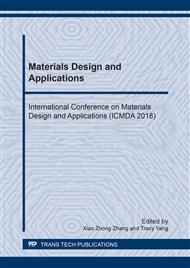[1]
M. Clara, B. Strenn, O. Gans, E. Martinez, N. Kreuzinger, and H. Kroiss, Removal of selected pharmaceuticals, fragrances and endocrine disrupting compounds in a membrane bioreactor and conventional wastewater treatment plants,, Water Res., vol. 39, no. 19, p.4797–4807, Nov. (2005).
DOI: 10.1016/j.watres.2005.09.015
Google Scholar
[2]
M.-K. Kim and K.-D. Zoh, Occurrence and removals of micropollutants in water environment,, Environ. Eng. Res., vol. 21, no. 4, p.319–332, Nov. (2016).
Google Scholar
[3]
E. J. Toone, Advances in Enzymology and Related Areas of Molecular Biology, Volume 75: Protein Evolution. John Wiley & Sons, (2010).
Google Scholar
[4]
B. Chefetz, Y. Chen, and Y. Hadar, Purification and Characterization of Laccase fromChaetomium thermophilium and Its Role in Humification,, Appl. Environ. Microbiol., vol. 64, no. 9, p.3175–3179, Sep. (1998).
DOI: 10.1128/aem.64.9.3175-3179.1998
Google Scholar
[5]
V. Madhavi and S. S. Lele, LACCASE: PROPERTIES AND APPLICATIONS,, BioResources, vol. 4, no. 4, p.1694–1717, Aug. (2009).
Google Scholar
[6]
W. Tischer and F. Wedekind, Immobilized Enzymes: Methods and Applications,, in Biocatalysis - From Discovery to Application, P. D. W.-D. Fessner, A. Archelas, D. C. Demirjian, R. Furstoss, H. Griengl, K.-E. Jaeger, E. Morís-Varas, R. Öhrlein, M. T. Reetz, J.-L. Reymond, M. Schmidt, S. Servi, P. C. Shah, W. Tischer, and F. Wedekind, Eds. Springer Berlin Heidelberg, 1999, p.95.
DOI: 10.1007/3-540-68116-7
Google Scholar
[7]
M. Maryšková, I. Ardao, C. A. García-González, L. Martinová, J. Rotková, and A. Ševců, Polyamide 6/chitosan nanofibers as support for the immobilization of Trametes versicolor laccase for the elimination of endocrine disrupting chemicals,, Enzyme Microb. Technol., vol. 89, p.31–38, Jul. (2016).
DOI: 10.1016/j.enzmictec.2016.03.001
Google Scholar
[8]
L. N. Nguyen et al., Continuous biotransformation of bisphenol A and diclofenac by laccase in an enzymatic membrane reactor,, Int. Biodeterior. Biodegrad., vol. 95, p.25–32, Nov. (2014).
Google Scholar
[9]
M. de Cazes et al., Design and optimization of an enzymatic membrane reactor for tetracycline degradation,, Catal. Today, vol. 236, p.146–152, Nov. (2014).
DOI: 10.1016/j.cattod.2014.02.051
Google Scholar
[10]
M. Fernández-Fernández, M. Á. Sanromán, and D. Moldes, Recent developments and applications of immobilized laccase,, Biotechnol. Adv., vol. 31, no. 8, p.1808–1825, Dec. (2013).
DOI: 10.1016/j.biotechadv.2012.02.013
Google Scholar
[11]
S. Yang, F. I. Hai, L. D. Nghiem, L. N. Nguyen, F. Roddick, and W. E. Price, Removal of bisphenol A and diclofenac by a novel fungal membrane bioreactor operated under non-sterile conditions,, Int. Biodeterior. Biodegrad., vol. 85, p.483–490, Nov. (2013).
DOI: 10.1016/j.ibiod.2013.03.012
Google Scholar
[12]
R. R. Nair, P. Demarche, and S. N. Agathos, Formulation and characterization of an immobilized laccase biocatalyst and its application to eliminate organic micropollutants in wastewater,, New Biotechnol., vol. 30, no. 6, p.814–823, Sep. (2013).
DOI: 10.1016/j.nbt.2012.12.004
Google Scholar
[13]
G. Hommes et al., Production of a robust nanobiocatalyst for municipal wastewater treatment,, Bioresour. Technol., vol. 115, p.8–15, Jul. (2012).
Google Scholar
[14]
G. Songulashvili, G. A. Jimenéz-Tobón, C. Jaspers, and M. J. Penninckx, Immobilized laccase of Cerrena unicolor for elimination of endocrine disruptor micropollutants,, Fungal Biol., vol. 116, no. 8, p.883–889, Aug. (2012).
DOI: 10.1016/j.funbio.2012.05.005
Google Scholar
[15]
P. Galliker, G. Hommes, D. Schlosser, P. F.-X. Corvini, and P. Shahgaldian, Laccase-modified silica nanoparticles efficiently catalyze the transformation of phenolic compounds,, J. Colloid Interface Sci., vol. 349, no. 1, p.98–105, Sep. (2010).
DOI: 10.1016/j.jcis.2010.05.031
Google Scholar
[16]
I. Matijošytė, I. W. C. E. Arends, S. de Vries, and R. A. Sheldon, Preparation and use of cross-linked enzyme aggregates (CLEAs) of laccases,, J. Mol. Catal. B Enzym., vol. 62, no. 2, p.142–148, Feb. (2010).
DOI: 10.1016/j.molcatb.2009.09.019
Google Scholar
[17]
H. Cabana, C. Alexandre, S. N. Agathos, and J. P. Jones, Immobilization of laccase from the white rot fungus Coriolopsis polyzona and use of the immobilized biocatalyst for the continuous elimination of endocrine disrupting chemicals,, Bioresour. Technol., vol. 100, no. 14, p.3447–3458, Jul. (2009).
DOI: 10.1016/j.biortech.2009.02.052
Google Scholar
[18]
D. S. Tawfik, Directed enzyme evolution: Screening and selection methods. Methods in molecular biology Vol. 230 edited by Frances H. Arnold and George Georgiou. 2003.,, Protein Sci. Publ. Protein Soc., vol. 13, no. 10, p.2836–2837, Oct. (2004).
DOI: 10.1002/cbic.200490009
Google Scholar
[19]
T. Hassani, S. Ba, and H. Cabana, Formation of enzyme polymer engineered structure for laccase and cross-linked laccase aggregates stabilization,, Bioresour. Technol., vol. 128, p.640–645, Jan. (2013).
DOI: 10.1016/j.biortech.2012.10.058
Google Scholar
[20]
R. Xu, R. Tang, Q. Zhou, F. Li, and B. Zhang, Enhancement of catalytic activity of immobilized laccase for diclofenac biodegradation by carbon nanotubes,, Chem. Eng. J., vol. 262, p.88–95, Feb. (2015).
DOI: 10.1016/j.cej.2014.09.072
Google Scholar
[21]
Y. Liu et al., Immobilization of laccase on magnetic bimodal mesoporous carbon and the application in the removal of phenolic compounds,, Bioresour. Technol., vol. 115, p.21–26, Jul. (2012).
Google Scholar


